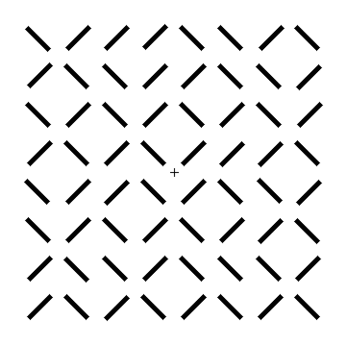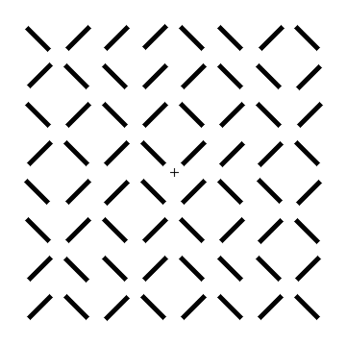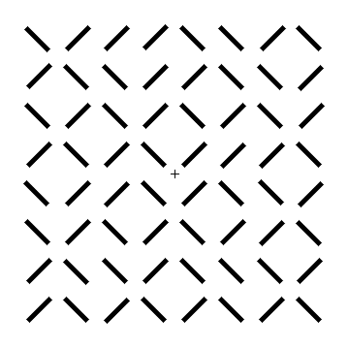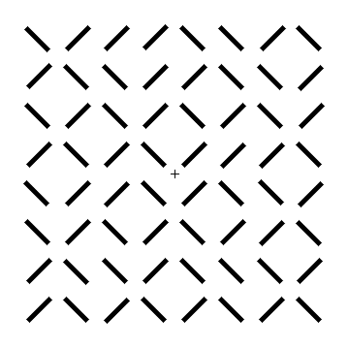Cued Visual Selection (CVS) - Demo
Hans-Christoph NothdurftVisual Perception Laboratory (VPL) Göttingen
Germany
In CVS experiments you are asked to identify the cued target in a crowd.
In the following examples you will see a regular array of oblique lines
each randomly tilted to the left or right.

At some time, a cue occurs, here a rectangular frame around one of the lines.

Can you tell to which side the cued line is tilted?
Of course, you can. This was a static example and you had plenty of time to make your decision.
But how does it look when patterns are shown for a shorter period of time and then are "masked"?
Masking means that all lines are replaced by something (here, a cross) from which you cannot decide what
was there before. Please fixate the central cross and do not look around.

Please try again and try to fixate better. (This example is easier to see than the following ones.)
Well, if you were finally able to see and identify at least some cued lines, we can make the task more difficult. (Please keep your eyes on the fixation cross.)

considerably shortened. It may require some exercise to see and identify all cued lines.
(And even if you think you could, you were perhaps not always correct.)
In the next example, we make the task even more difficult.

In fact, all lines were masked at the very same moment when the cue was shown; thus, no single line but only crosses were cued. If you nevertheless felt that you could identify some lines, you might have been systematically wrong; this artifact is discussed in one of my papers on CVS (see below).
And now, the last example.
Please try to identify the line at the cued location, that was presented before
the mask.

What do the examples show?
•
You cannot reliably identify cued lines when the presentation time between cue and mask is too short
(even when the lines were clearly visible and shown for a long time beforehand).
•
Cues mark one of the lines and supposedly attract your visual processing resources to that location.
In the literature on vision research this is often described as a "shift of visual attention".
•
With oriented lines (as shown here) you likely cannot memorize the visible pattern beforehand
(provided the line sample is large enough). That is, it does not help to see the pattern for a long time;
the presentation time between cue and mask is crucial for your performance.
Interestingly, the required presentation time after cue onset varies considerably along stimulus presentation and allows for conclusions on the underlying neural responses. This suggests that CVS might be a helpful tool to look into brain activities of otherwise unconscious processes.
Performance variations as in the demos were studied in detail in a number of experimental studies that were
published (or will soon be published) in
vpl-reports.de (open and free access).
You may have noticed that (for the reason of simpler pattern generation) the line pattern in the demo pictures does not change. This may help you to control whether your line identifications were correct or not. In true experiments, however, line patterns were refreshed in every trial. In addition, other cues than rectangular frames were used and lines were shown in slightly different configurations than in the demo pictures above, including a positional jitter in some experiments.
Christoph Nothdurft
VPL-Göttingen
15-Nov-2017